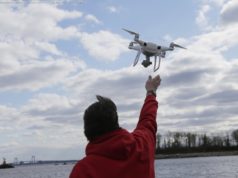The meteor shower will peak between Saturday April 21 and Sunday April 22.
It takes 415.5 years for a comet called C/1861 G1 Thatcher to circle to sun. But every year in late April, our planet plows into the trail of dust the comet has left behind in its long journey around the sun. These bits of debris burn up in our atmosphere and stream across the night sky in bright streaks. It’s the Lyrid meteor shower. And we can watch it peak overnight between Saturday, April 21, and Sunday, April 22.
The Lyrids are so named because they appear to radiate out from the constellation Lyra. On the night of April 21 and 22, in the Northern Hemisphere, Lyra will rise in the northeastern sky in the early evening and move nearly directly overhead during the night, like so:
Lyra is pretty easy to spot, as it includes the star Vega, which is among the brightest in the night sky. You don’t need to be looking directly at Lyra to see the show, though, because the meteors will shoot out in all directions.
The moon (which will be half full) will set for the evening around 2 am ET . (Check here for the exact moonset time in your area.) For a few hours after that, the sky will be nice and extra dark for meteor viewing.
The best time to look, the website EarthSky recommends, is right before dawn. That’s when Lyra will be nearly directly overhead. (To find out exactly where to look, I recommend trying out a GPS-enabled stargazing app like SkyGuide .)
At the meteors’ peak, NASA estimates you may be able to see up to 20 per hour. But for the best meteor hunting, be sure to find a dark patch of sky, away from bright city lights. Just lie on the ground with your feet facing east, NASA recommends, and let your eyes adjust to the darkness.
When you spot a meteor, you’re seeing a speck of space debris reach about 3,000 degrees Fahrenheit as it burns up in our atmosphere. Some will leave bright trails behind them. That’s ionized gas (i.e., energized gas, not unlike the light you see from neon lamps) glowing in the meteors’ wake.
The comet C/1861 G1 Thatcher won’t return to our neighborhood in the solar system until the year 2276. But take this as your annual chance to see some small part of it.
If you miss the Lyrids, don’t worry. There are plenty more meteor showers to spot this year.
The Eta Aquarids alight the sky on May 6 and 7. Then, the Perseids, arguably the best meteor shower of the year, will peak around August 13. After that, the Orionids appear in October, and the Leonids in November.






